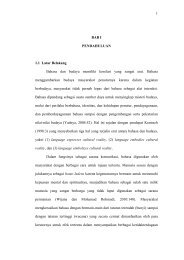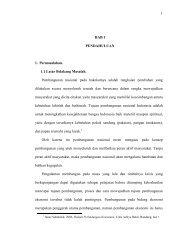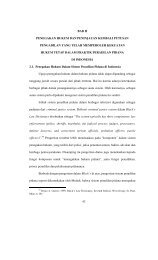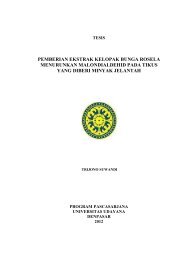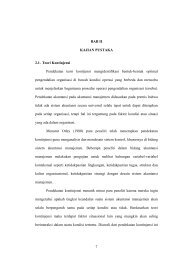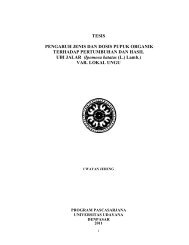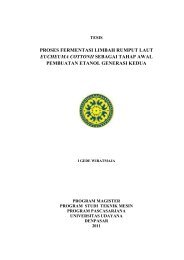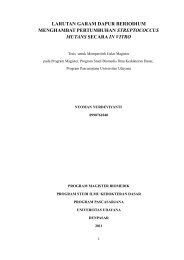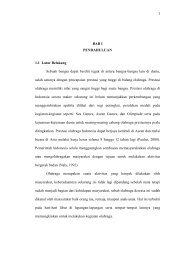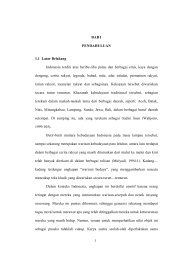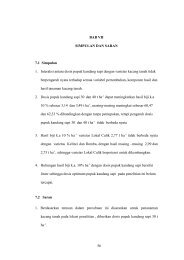A STUDY ON OLIVER TWIST'S INFERIORITY - Universitas Udayana
A STUDY ON OLIVER TWIST'S INFERIORITY - Universitas Udayana
A STUDY ON OLIVER TWIST'S INFERIORITY - Universitas Udayana
You also want an ePaper? Increase the reach of your titles
YUMPU automatically turns print PDFs into web optimized ePapers that Google loves.
THESIS<br />
THE FIDELITY MEANING OF COMPOUND WORDS’<br />
TRANSLATI<strong>ON</strong> IN NEW MO<strong>ON</strong> NOVEL<br />
PUTU DESI ANGGERINA HIKMAHARYANTI<br />
1190161046<br />
MASTER PROGRAM<br />
LINGUISTIC PROGRAM IN TRANSLATI<strong>ON</strong> STUDIES<br />
POSTGRADUATE PROGRAM<br />
UDAYANA UNIVERSITY<br />
DENPASAR<br />
2013<br />
ii
THE FIDELITY MEANING OF COMPOUND WORDS’<br />
TRANSLATI<strong>ON</strong> IN NEW MO<strong>ON</strong> NOVEL<br />
Thesis as a fulfillment to obtain<br />
a Master Degree in Translation Studies,<br />
Postgraduate Program, <strong>Udayana</strong> University<br />
PUTU DESI ANGGERINA HIKMAHARYANTI<br />
1190161046<br />
MASTER PROGRAM<br />
LINGUISTIC PROGRAM IN TRANSLATI<strong>ON</strong> STUDIES<br />
POSTGRADUATE PROGRAM<br />
UDAYANA UNIVERSITY<br />
DENPASAR<br />
2013<br />
iii
APPROVAL SHEET<br />
This thesis has been examined on October 3 rd , 2013<br />
by<br />
Supervisor I,<br />
Supervisor II,<br />
Prof. Dr. Made Budiarsa, M.A.<br />
NIP 19530107 198103 1 002<br />
Dr. Dra. Ni Wayan Sukarini, M.Hum.<br />
NIP 19590109 198403 2 001<br />
Acknowledged by,<br />
Head of Master Program in Linguistics<br />
Postgraduate Program<br />
<strong>Udayana</strong> University,<br />
Director of Postgraduate Program<br />
<strong>Udayana</strong> University,<br />
Prof. Dr. I Nyoman Suparwa, M.Hum.<br />
NIP 19620310 198503 1 005<br />
Prof. Dr. dr. A.A. Raka Sudewi, Sp.S(K)<br />
NIP 19590215 1985102 001<br />
iv
This thesis has been examined by the Board of Examiners on October 3 rd , 2013<br />
based on the Decree of Rector of <strong>Udayana</strong> University No. 1876/UN14.4/HK/2013<br />
dated October 3 rd , 2013<br />
The Board of Examiners:<br />
Chairman : Prof. Dr. Made Budiarsa, M.A.<br />
Secretary : Dr. Dra. Ni Wayan Sukarini, M.Hum.<br />
Members : 1. Prof. Drs. Ketut Artawa, M.A, Ph.D.<br />
2. Dr. NL Ketut Mas Indrawati, M.A.<br />
3. Dr. I Nyoman Sedeng, M.Hum.<br />
v
SURAT PERNYATAAN BEBAS PLAGIAT<br />
Saya yang bertanda tangan di bawah ini:<br />
Nama<br />
: Putu Desi Anggerina Hikmaharyanti, S.S.<br />
NIM : 1190161046<br />
Program Studi : Magister (S2) Linguistik, Konsentrasi Penerjemahan,<br />
Program Pascasarjana, <strong>Universitas</strong> <strong>Udayana</strong><br />
Judul Tesis : The Fidelity Meaning of Compound Words’ Translation<br />
in New Moon Novel<br />
Dengan in menyatakan bahwa karya ilmiah Tesis ini bebas plagiat.<br />
Apabila dikemudian hari terbukti terdapat plagiat dalam karya ilmiah ini, maka<br />
saya bersedia menerima sanksi sesuai peraturan Mendiknas Republik Indonesia<br />
No. 17 Tahun 2010 dan peraturan perundangan yang berlaku.<br />
Denpasar, October 2013<br />
Putu Desi Anggerina Hikmaharyanti<br />
vi
ACKNOWLEDGEMENT<br />
First of all, it is a great honor to dedicate the best gratitude of mine to Sang<br />
Hyang Widhi Wasa, due to His marvelous blessing for me. He never lets me<br />
undergo this life alone and I always feel His miracles every time.<br />
On this occasion, I am also eager to address my sincerest gratitude to:<br />
1. Prof. Dr. Made Budiarsa, M.A as my first supervisor for his professional<br />
guidance and Dr. Dra. Ni Wayan Sukarini, M.Hum as my second<br />
supervisor for her valuable suggestions. They patiently guided me in<br />
composing this thesis, corrected the drafts, and discussed the stuffs.<br />
Moreover, I would like to thank all of the Board of Examiners my<br />
lecturers who had given me many important inputs to improve my thesis.<br />
2. The Director of Postgraduate Program of <strong>Udayana</strong> University: Prof. Dr.<br />
Dr. A.A. Raka Sudewi, Sp.S(K), The Head of Master Program in<br />
Linguistics: Prof. Dr. I Nyoman Suparwa, M.Hum, the secretary and staff<br />
and the Coordinator of Translation Study Program;<br />
3. I am truly grateful to my father and mother for their supports to finish my<br />
study both spiritually and financially. My gratefulness also goes to my<br />
sisters Unik and Utik, moreover my beloved husband for their help and<br />
prayer that this research may come into its end properly.<br />
4. For all my partners in La Denpasar and Mahasaraswati University, also<br />
all my friends in Translation Studies, you are the great people I have ever<br />
met.<br />
vii
Apart from the supervision and all other supports, any lack of information or<br />
mistakes in this thesis both in terms of techniques and contents are my<br />
responsibilities as the reseacher. Hopefully this thesis is beneficial for my alma<br />
mater, <strong>Udayana</strong> University especially in Translation studies.<br />
Denpasar, October 2013<br />
Putu Desi Anggerina Hikmaharyanti<br />
viii
ABSTRAK<br />
Penelitian ini membahas tentang kesetiaan makna pada terjemahan kata<br />
majemuk dari bahasa Inggris ke dalam bahasa Indonesia yang terdapat dalam<br />
novel New Moon karya Stephenie Meyer yang diterjemahkan ke dalam bahasa<br />
Indonesia berjudul Dua Cinta oleh Chresnayani. Kata majemuk bahasa Inggris<br />
memiliki aturan yang kuat secara struktur baik kata benda maupun kata sifat.<br />
Penelitian ini juga membahas tentang teknik penerjemahan untuk mendapatkan<br />
kesetiaan makna, termasuk di dalamnya terjemahan yang mungkin berbeda<br />
pandangan dengan penulis berdasarkan pengetahuan yang dimiliki.<br />
Mengacu pada bahasan masalah, teori-teori dalam penelitian ini mencakup<br />
teori kesetiaan makna, kata majemuk, terjemahan, metode terjemahan sebagai<br />
pendukung bersama dengan ketidaktetapan terjemahan dan teori berdasarkan<br />
pengetahuan. Data penelitian ini adalah kata-kata majemuk dalam bahasa Inggris<br />
yang diterjemahkan ke dalam bahasa Indonesia.<br />
Penelitian ini menerapkan metode deskriptif kualitatif yang datanya diperoleh<br />
dari penelitian perpustakaan. Data selanjutnya dianalisis untuk mengetahi bentuk<br />
dan kategori kata majemuk tersebut beserta kesetiaan maknanya melalui metode<br />
terjemahan dan terjemahan yang mungkin diaplikasikan.<br />
Jumlah keseluruhan data adalah 209 dengan menerapkan metode total<br />
sampling. Hasil menunjukkan bentuk sambung sebanyak 110 data (52,63%) ,<br />
bentuk dengan tanda hubung sebanyak 69 data (33,01%), dan bentuk terpisah<br />
sebanyak 30 data (14,35%). Berdasarkan kategori 164 data termasuk dalam kata<br />
benda majemuk dan 45 data kata sifat majemuk. Prosedur yang digunakan<br />
meliputi peminjaman, calque, literal, transposisi, modulasi, ekuivalen, dan<br />
adaptasi. Namun, untuk modulasi tidak terdapat dalam data. Seluruh terjemahan<br />
bisa dikatakan benar dan tidak satupun penerjemah setuju dengan persepsi<br />
penerjemah lainnya, karena memiliki perbedaan pengetahuan serta pengalaman.<br />
Kata kunci: kesetiaan makna, kata majemuk, terjemahan.<br />
ix
ABSTRACT<br />
This research focuses on the fidelity meaning of English compound words’<br />
translation into Indonesian in Stephenie Meyer New Moon which is translated into<br />
Indonesian by Chresnayani Dua Cinta. Since the rules of English compound<br />
words are strong structurally either noun or adjective word class. This research<br />
also focuses on the methods in translating the English compound words into<br />
Indonesian in order to have fidelity meaning. This research also provides the<br />
translation possibility according to different perceptions and knowledge the<br />
researcher has.<br />
Due to the problems discussed, the theories suggested in this research<br />
include fidelity meaning, compound word, translation, translation procedures as<br />
supporting theory together with translation indeterminacy and knowledge based<br />
theory. The research data is the English compound words found rendered into<br />
Indonesian in the novel.<br />
The method applied in this research is descriptive qualitative in nature.<br />
Further, the data is collected by applying library research. Then, the data analysis<br />
is performed to search the form and category of the compound words, then the<br />
fidelity meaning through translation methods, and the possible translations<br />
applied.<br />
The total number of the data is 209 and the total sampling is applied in this<br />
research. The result of the data analysis shows that closed form reaches 110 data<br />
(52.63%) , the hyphenated form has 69 data (33,01%), and t he open form<br />
influences 30 data (14,35%). Moreover, according to all categories, it reaches 164<br />
data of noun compounds and 45 data of adjective compounds. Further, the<br />
procedures include borrowing, calque, literal, transposition, modulation,<br />
equivalence, and adaptation. Unfortunately, modulation is not applied in the<br />
translations. In addition, all of which (both the translator and the researcher’s<br />
point of views) could be correct, and none of the translators will agree with the<br />
others’ perceptions, because both propose different knowledge of their<br />
experiences.<br />
Keywords: fidelity meaning, compound words, translation.<br />
x
TABLE OF C<strong>ON</strong>TENTS<br />
C<strong>ON</strong>TENTS<br />
PAGE<br />
COVER ………………………………………………………………….... i<br />
PREQUISITE TITLE …………………………………………………...... iii<br />
APPROVAL SHEET ……………………………………………………... iv<br />
THE BOARDS OF EXAMINERS ……………………………………….. v<br />
SURAT PERNYATAAN BEBAS PLAGIAT …………………………… vi<br />
ACKNOWLEDGEMENT ………………………………………………... vii<br />
ABSTRAK ………………………………………………………………... ix<br />
ABSTRACT ………………………………………………………………. x<br />
TABLE OF C<strong>ON</strong>TENTS …………………………………………………. xi<br />
CHAPTER I INTRODUCTI<strong>ON</strong> ………………………………………….. 1<br />
1.1 Background of the Study …………………………………………...... 1<br />
1.2 Problems of the Study …………………………………....................... 3<br />
1.3 Aims of the Study …………………………………………….............. 4<br />
1.3.1 General Aims ………………………………………………….…......4<br />
1.3.2 Specific Aims ……………………………….…………..................... 4<br />
1.4 Significance of the Study …………………………………………...... 4<br />
1.4.1 Theoretical Significance ……………………………………………..5<br />
1.4.2 Practical Significance ………………………………………………. 5<br />
1.5 Scope of the Study …………………………………………………… 6<br />
CHAPTER II LITERATURE REVIEW, C<strong>ON</strong>CEPT, THEORETICAL<br />
FRAMEWORK, AND RESEARCH MODEL ………………………........ 7<br />
2.1 Literature Review …………………………………………………....... 7<br />
2.2 Concept …………………………………………………....................... 9<br />
2.2.1 Fidelity Meaning ………………………………….………………….10<br />
2.2.2 Compound Word .…………………………….................................... 11<br />
2.2.3 Translation …………………………………………………............... 12<br />
2.3 Theoretical Framework ……………………………………………...... 13<br />
2.3.1 Compound Words’ Classification ……………..……………............. 14<br />
2.3.2 Translation Process ………………………………………….............. 16<br />
2.3.3 Translation Methods ………………………………............................ 19<br />
2.3.4 Semantics ……………………………………………........................ 23<br />
2.3.5 Translation Indeterminacy …………………………………………... 24<br />
2.3.6 Knowledge Based Theory …...……………………………….............26<br />
2.4 Research Model ……………………………………………………….. 26<br />
CHAPTER III RESEARCH METHOD ………………………………….. 28<br />
3.1 Research Design ……………………………………………………..... 28<br />
3.2 Research Location …………………………………………………….. 29<br />
3.3 Data Source …………………………………………………................ 29<br />
xi
3.4 Research Instruments ………………………………………………..... 29<br />
3.5 Method and Technique of Collecting Data …………………………… 29<br />
3.6 Method and Technique of Analyzing Data …………………………… 30<br />
3.7 Method and Technique of Presenting Data Analysis ………………..... 31<br />
CHAPTER IV ANALYSIS OF FIDELITY MEANING OF COMPOUND<br />
WORDS …………………………………....……………………………… 33<br />
4.1 Characteristics of English Compound Words ……………………….…33<br />
4.1.1 The Form of English Compound Words .…………………….……....34<br />
4.1.1.1 Close form …………………………………..……………………...34<br />
4.1.1.2 Hyphenated form …………………………………………………...36<br />
4.1.1.3 Open form …………………………………………………………. 38<br />
4.1.2 The Types of English Compound Words …............................……….40<br />
4.1.2.1 Noun Compounds …………………………………………………. 41<br />
4.1.2.1.1 Subject and Verb …………………………………........................41<br />
4.1.2.1.2 Verb and Object …………………………………………………. 44<br />
4.1.2.1.3 Verb and Adverbial ……………………………..………………. 47<br />
4.1.2.1.4 Verb less compounds …………………………...…...................... 50<br />
4.1.2.1.5 Subject and Complement ………………………..………………. 50<br />
4.1.2.1.6 Combining-form compounds …………………..….......................51<br />
4.1.2.1.7 Bahuvrihi Compounds ………………………..…………………. 52<br />
4.1.2.2 Adjective Compounds …..……………………..……...…............... 52<br />
4.1.2.2.1 Verb and Object ……………….…………………....................... 53<br />
4.1.2.2.2 Verb and Adverbial …...……….…………………....................... 54<br />
4.1.2.2.3 Verb less ……………………….…………………....................... 56<br />
4.2 The Fidelity Meaning of Compound Word’s Translation by<br />
Translation Procedures ……….…….…………………….………...............58<br />
4.2.1 Borrowing ………………………...……….…………………............59<br />
4.2.2 Calque ……………….………………….............................................63<br />
4.2.3 Literal Translation ……………………………………………........... 66<br />
4.2.4 Transposition ………………………………………………………... 70<br />
4.2.5 Modulation …………………………………………………….......... 73<br />
4.2.6 Equivalence …………………………………………………………. 74<br />
4.2.7 Adaptation ……………………………………………………........... 77<br />
4.3 The Possible Translation of Compound Words ………………….…….80<br />
CHAPTER V C<strong>ON</strong>CLUSI<strong>ON</strong> AND SUGGESTI<strong>ON</strong> ……………………. 84<br />
4.1 Conclusion ………………………………………………………......... 84<br />
4.2 Suggestion ……………………………………………………………..86<br />
BIBILIOGRAPHY …………………………………………………........... 87<br />
DATA APPENDIX ……………………………………………………….. 89<br />
xii




